The Extent of Recreational Drug Use as a Form of Leisure (SPRC 1004)
VerifiedAdded on 2023/01/04
|7
|2521
|40
Essay
AI Summary
This essay explores the multifaceted relationship between recreational drug use and leisure, examining the motivations behind drug consumption, the classification of various substances as recreational, and the psychological and physiological effects of these drugs. The essay delves into the concept of drug addiction, discussing tolerance, withdrawal symptoms, and the impact of drug use on both individuals and society. It also touches upon the ethical considerations surrounding drug dependence and explores various treatment methods, including rehabilitation programs and cognitive techniques. Furthermore, the essay highlights the significance of recognizing drug abuse and the importance of understanding the potential for misuse of various substances, including those often considered harmless like caffeine and nicotine. The conclusion emphasizes the complex nature of drug use and the need for a comprehensive approach to address the issue.
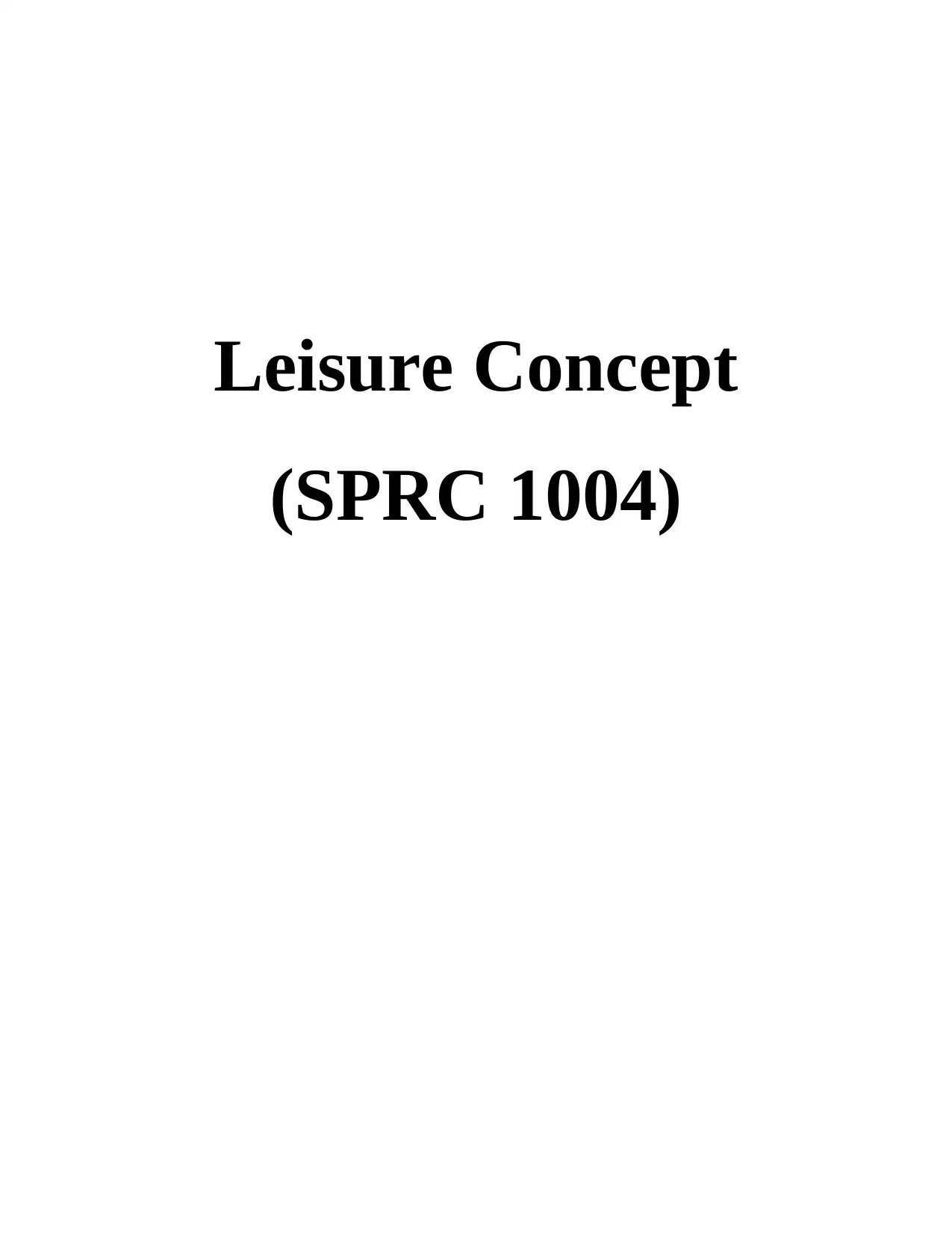
Leisure Concept
(SPRC 1004)
(SPRC 1004)
Paraphrase This Document
Need a fresh take? Get an instant paraphrase of this document with our AI Paraphraser
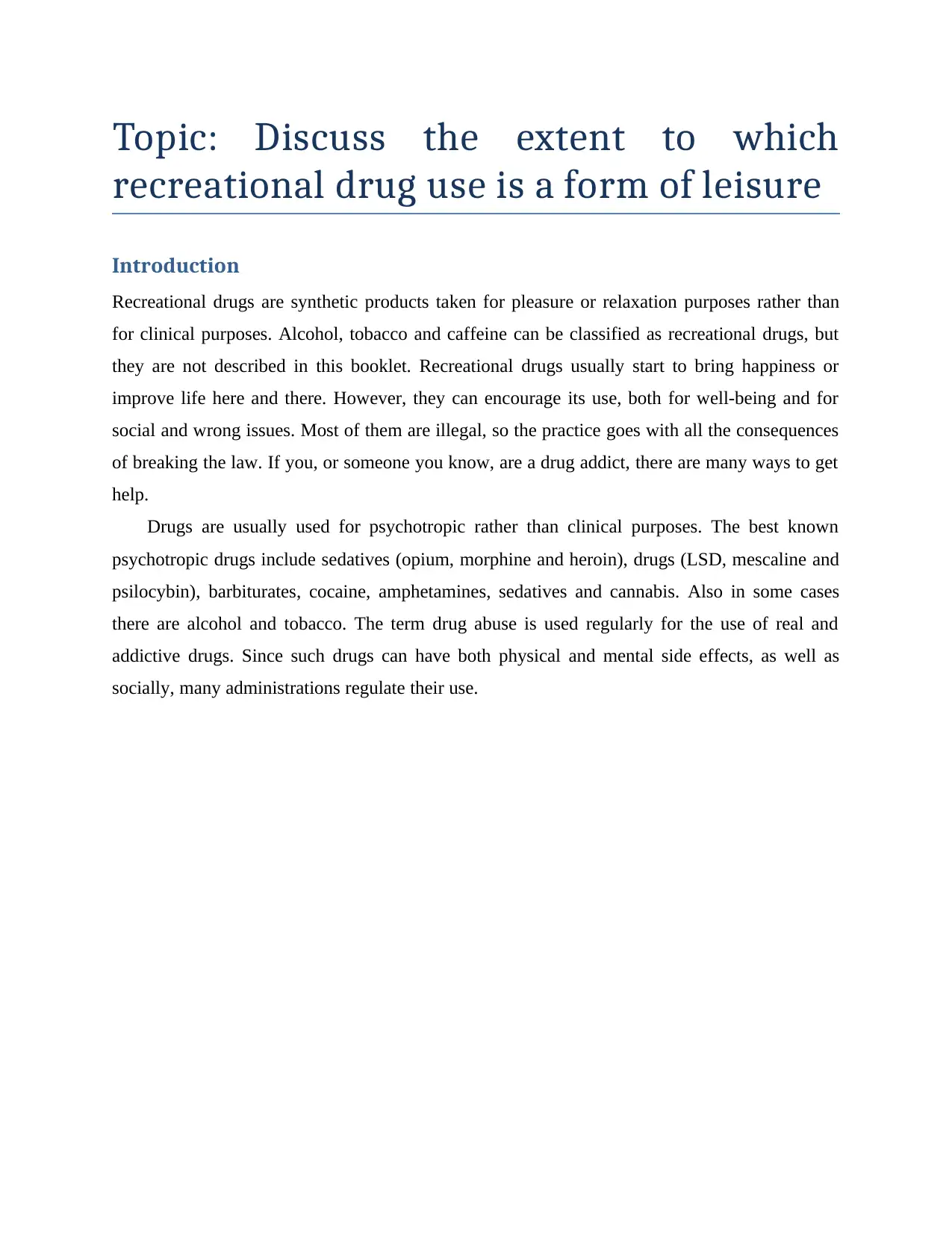
Topic: Discuss the extent to which
recreational drug use is a form of leisure
Introduction
Recreational drugs are synthetic products taken for pleasure or relaxation purposes rather than
for clinical purposes. Alcohol, tobacco and caffeine can be classified as recreational drugs, but
they are not described in this booklet. Recreational drugs usually start to bring happiness or
improve life here and there. However, they can encourage its use, both for well-being and for
social and wrong issues. Most of them are illegal, so the practice goes with all the consequences
of breaking the law. If you, or someone you know, are a drug addict, there are many ways to get
help.
Drugs are usually used for psychotropic rather than clinical purposes. The best known
psychotropic drugs include sedatives (opium, morphine and heroin), drugs (LSD, mescaline and
psilocybin), barbiturates, cocaine, amphetamines, sedatives and cannabis. Also in some cases
there are alcohol and tobacco. The term drug abuse is used regularly for the use of real and
addictive drugs. Since such drugs can have both physical and mental side effects, as well as
socially, many administrations regulate their use.
recreational drug use is a form of leisure
Introduction
Recreational drugs are synthetic products taken for pleasure or relaxation purposes rather than
for clinical purposes. Alcohol, tobacco and caffeine can be classified as recreational drugs, but
they are not described in this booklet. Recreational drugs usually start to bring happiness or
improve life here and there. However, they can encourage its use, both for well-being and for
social and wrong issues. Most of them are illegal, so the practice goes with all the consequences
of breaking the law. If you, or someone you know, are a drug addict, there are many ways to get
help.
Drugs are usually used for psychotropic rather than clinical purposes. The best known
psychotropic drugs include sedatives (opium, morphine and heroin), drugs (LSD, mescaline and
psilocybin), barbiturates, cocaine, amphetamines, sedatives and cannabis. Also in some cases
there are alcohol and tobacco. The term drug abuse is used regularly for the use of real and
addictive drugs. Since such drugs can have both physical and mental side effects, as well as
socially, many administrations regulate their use.
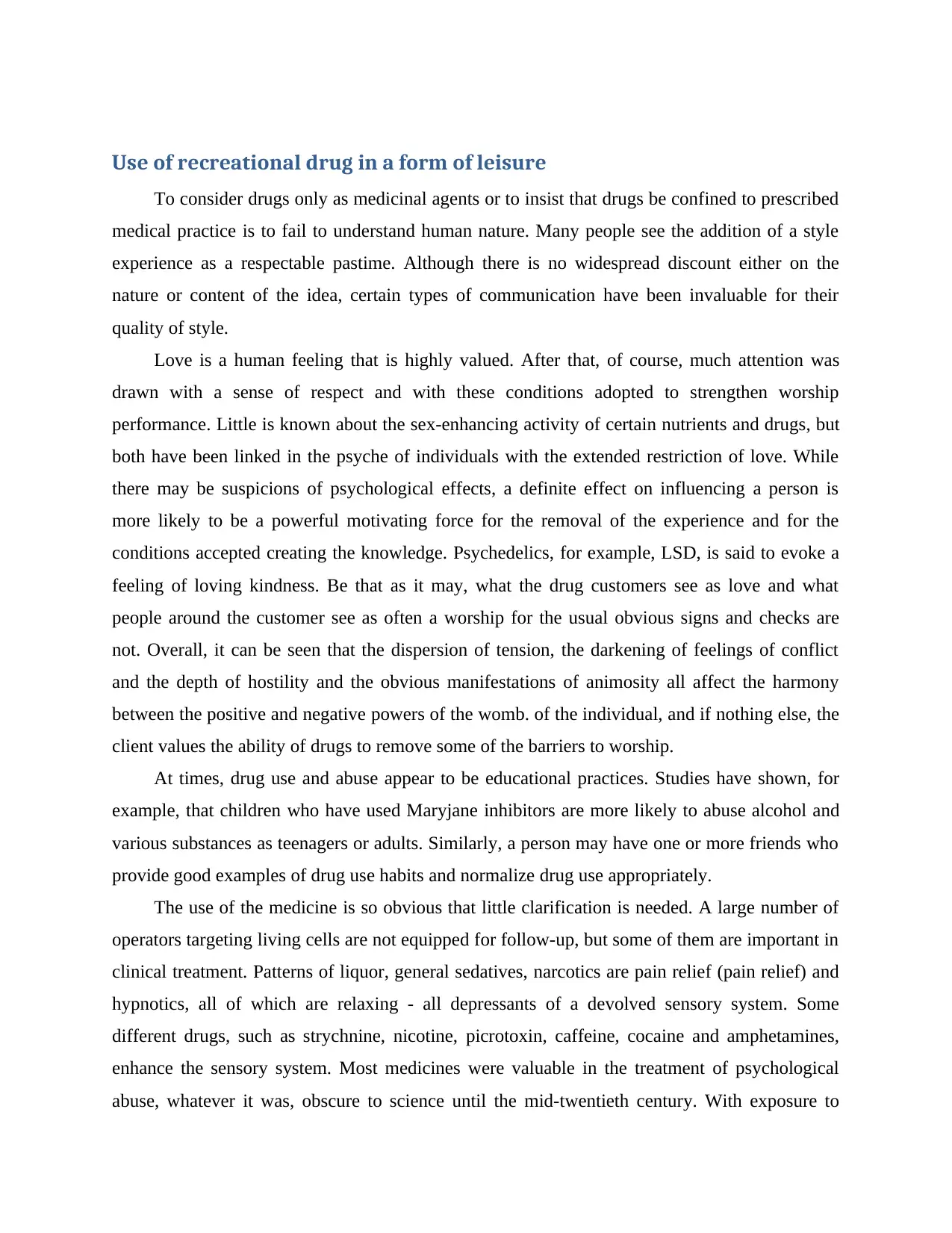
Use of recreational drug in a form of leisure
To consider drugs only as medicinal agents or to insist that drugs be confined to prescribed
medical practice is to fail to understand human nature. Many people see the addition of a style
experience as a respectable pastime. Although there is no widespread discount either on the
nature or content of the idea, certain types of communication have been invaluable for their
quality of style.
Love is a human feeling that is highly valued. After that, of course, much attention was
drawn with a sense of respect and with these conditions adopted to strengthen worship
performance. Little is known about the sex-enhancing activity of certain nutrients and drugs, but
both have been linked in the psyche of individuals with the extended restriction of love. While
there may be suspicions of psychological effects, a definite effect on influencing a person is
more likely to be a powerful motivating force for the removal of the experience and for the
conditions accepted creating the knowledge. Psychedelics, for example, LSD, is said to evoke a
feeling of loving kindness. Be that as it may, what the drug customers see as love and what
people around the customer see as often a worship for the usual obvious signs and checks are
not. Overall, it can be seen that the dispersion of tension, the darkening of feelings of conflict
and the depth of hostility and the obvious manifestations of animosity all affect the harmony
between the positive and negative powers of the womb. of the individual, and if nothing else, the
client values the ability of drugs to remove some of the barriers to worship.
At times, drug use and abuse appear to be educational practices. Studies have shown, for
example, that children who have used Maryjane inhibitors are more likely to abuse alcohol and
various substances as teenagers or adults. Similarly, a person may have one or more friends who
provide good examples of drug use habits and normalize drug use appropriately.
The use of the medicine is so obvious that little clarification is needed. A large number of
operators targeting living cells are not equipped for follow-up, but some of them are important in
clinical treatment. Patterns of liquor, general sedatives, narcotics are pain relief (pain relief) and
hypnotics, all of which are relaxing - all depressants of a devolved sensory system. Some
different drugs, such as strychnine, nicotine, picrotoxin, caffeine, cocaine and amphetamines,
enhance the sensory system. Most medicines were valuable in the treatment of psychological
abuse, whatever it was, obscure to science until the mid-twentieth century. With exposure to
To consider drugs only as medicinal agents or to insist that drugs be confined to prescribed
medical practice is to fail to understand human nature. Many people see the addition of a style
experience as a respectable pastime. Although there is no widespread discount either on the
nature or content of the idea, certain types of communication have been invaluable for their
quality of style.
Love is a human feeling that is highly valued. After that, of course, much attention was
drawn with a sense of respect and with these conditions adopted to strengthen worship
performance. Little is known about the sex-enhancing activity of certain nutrients and drugs, but
both have been linked in the psyche of individuals with the extended restriction of love. While
there may be suspicions of psychological effects, a definite effect on influencing a person is
more likely to be a powerful motivating force for the removal of the experience and for the
conditions accepted creating the knowledge. Psychedelics, for example, LSD, is said to evoke a
feeling of loving kindness. Be that as it may, what the drug customers see as love and what
people around the customer see as often a worship for the usual obvious signs and checks are
not. Overall, it can be seen that the dispersion of tension, the darkening of feelings of conflict
and the depth of hostility and the obvious manifestations of animosity all affect the harmony
between the positive and negative powers of the womb. of the individual, and if nothing else, the
client values the ability of drugs to remove some of the barriers to worship.
At times, drug use and abuse appear to be educational practices. Studies have shown, for
example, that children who have used Maryjane inhibitors are more likely to abuse alcohol and
various substances as teenagers or adults. Similarly, a person may have one or more friends who
provide good examples of drug use habits and normalize drug use appropriately.
The use of the medicine is so obvious that little clarification is needed. A large number of
operators targeting living cells are not equipped for follow-up, but some of them are important in
clinical treatment. Patterns of liquor, general sedatives, narcotics are pain relief (pain relief) and
hypnotics, all of which are relaxing - all depressants of a devolved sensory system. Some
different drugs, such as strychnine, nicotine, picrotoxin, caffeine, cocaine and amphetamines,
enhance the sensory system. Most medicines were valuable in the treatment of psychological
abuse, whatever it was, obscure to science until the mid-twentieth century. With exposure to
⊘ This is a preview!⊘
Do you want full access?
Subscribe today to unlock all pages.

Trusted by 1+ million students worldwide
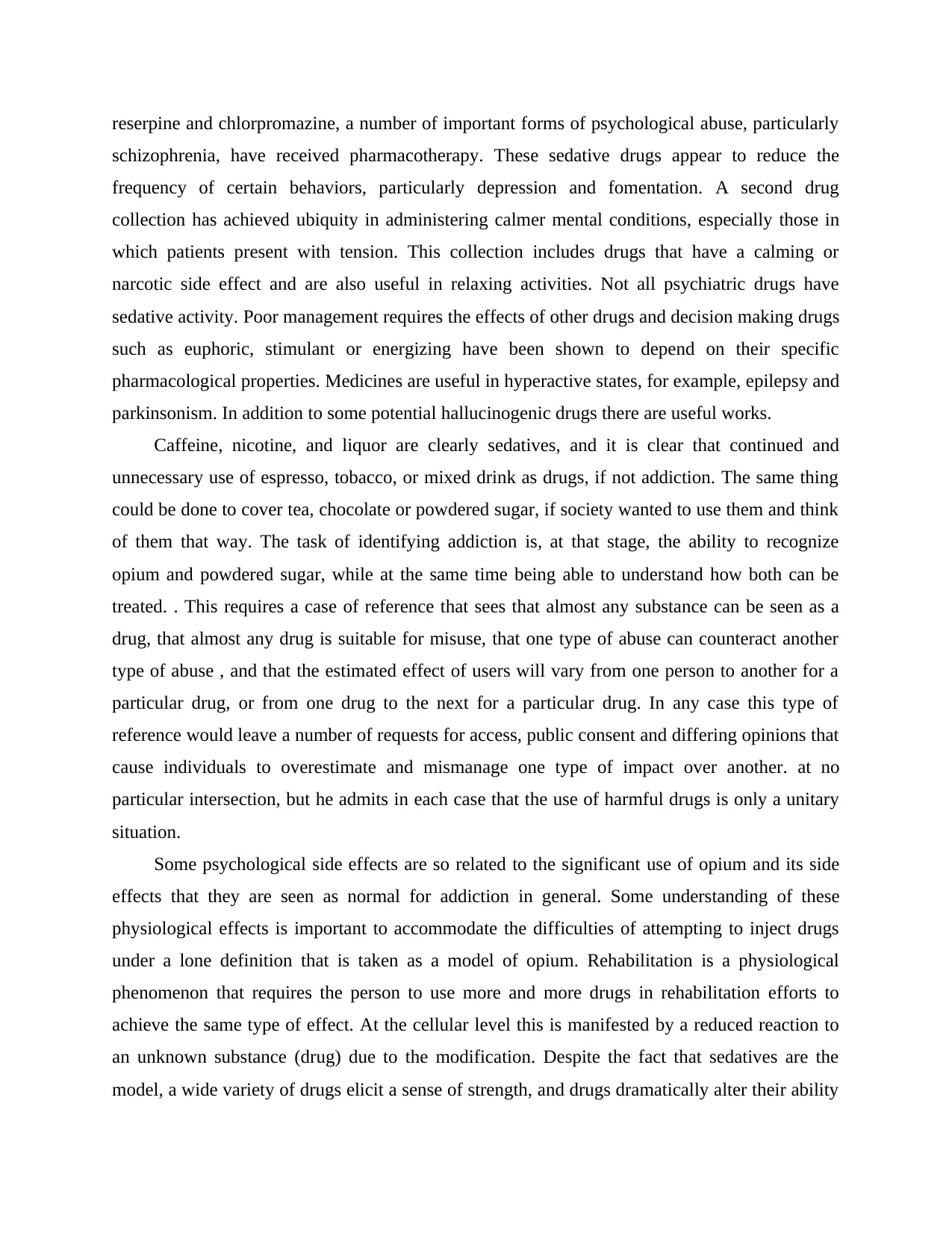
reserpine and chlorpromazine, a number of important forms of psychological abuse, particularly
schizophrenia, have received pharmacotherapy. These sedative drugs appear to reduce the
frequency of certain behaviors, particularly depression and fomentation. A second drug
collection has achieved ubiquity in administering calmer mental conditions, especially those in
which patients present with tension. This collection includes drugs that have a calming or
narcotic side effect and are also useful in relaxing activities. Not all psychiatric drugs have
sedative activity. Poor management requires the effects of other drugs and decision making drugs
such as euphoric, stimulant or energizing have been shown to depend on their specific
pharmacological properties. Medicines are useful in hyperactive states, for example, epilepsy and
parkinsonism. In addition to some potential hallucinogenic drugs there are useful works.
Caffeine, nicotine, and liquor are clearly sedatives, and it is clear that continued and
unnecessary use of espresso, tobacco, or mixed drink as drugs, if not addiction. The same thing
could be done to cover tea, chocolate or powdered sugar, if society wanted to use them and think
of them that way. The task of identifying addiction is, at that stage, the ability to recognize
opium and powdered sugar, while at the same time being able to understand how both can be
treated. . This requires a case of reference that sees that almost any substance can be seen as a
drug, that almost any drug is suitable for misuse, that one type of abuse can counteract another
type of abuse , and that the estimated effect of users will vary from one person to another for a
particular drug, or from one drug to the next for a particular drug. In any case this type of
reference would leave a number of requests for access, public consent and differing opinions that
cause individuals to overestimate and mismanage one type of impact over another. at no
particular intersection, but he admits in each case that the use of harmful drugs is only a unitary
situation.
Some psychological side effects are so related to the significant use of opium and its side
effects that they are seen as normal for addiction in general. Some understanding of these
physiological effects is important to accommodate the difficulties of attempting to inject drugs
under a lone definition that is taken as a model of opium. Rehabilitation is a physiological
phenomenon that requires the person to use more and more drugs in rehabilitation efforts to
achieve the same type of effect. At the cellular level this is manifested by a reduced reaction to
an unknown substance (drug) due to the modification. Despite the fact that sedatives are the
model, a wide variety of drugs elicit a sense of strength, and drugs dramatically alter their ability
schizophrenia, have received pharmacotherapy. These sedative drugs appear to reduce the
frequency of certain behaviors, particularly depression and fomentation. A second drug
collection has achieved ubiquity in administering calmer mental conditions, especially those in
which patients present with tension. This collection includes drugs that have a calming or
narcotic side effect and are also useful in relaxing activities. Not all psychiatric drugs have
sedative activity. Poor management requires the effects of other drugs and decision making drugs
such as euphoric, stimulant or energizing have been shown to depend on their specific
pharmacological properties. Medicines are useful in hyperactive states, for example, epilepsy and
parkinsonism. In addition to some potential hallucinogenic drugs there are useful works.
Caffeine, nicotine, and liquor are clearly sedatives, and it is clear that continued and
unnecessary use of espresso, tobacco, or mixed drink as drugs, if not addiction. The same thing
could be done to cover tea, chocolate or powdered sugar, if society wanted to use them and think
of them that way. The task of identifying addiction is, at that stage, the ability to recognize
opium and powdered sugar, while at the same time being able to understand how both can be
treated. . This requires a case of reference that sees that almost any substance can be seen as a
drug, that almost any drug is suitable for misuse, that one type of abuse can counteract another
type of abuse , and that the estimated effect of users will vary from one person to another for a
particular drug, or from one drug to the next for a particular drug. In any case this type of
reference would leave a number of requests for access, public consent and differing opinions that
cause individuals to overestimate and mismanage one type of impact over another. at no
particular intersection, but he admits in each case that the use of harmful drugs is only a unitary
situation.
Some psychological side effects are so related to the significant use of opium and its side
effects that they are seen as normal for addiction in general. Some understanding of these
physiological effects is important to accommodate the difficulties of attempting to inject drugs
under a lone definition that is taken as a model of opium. Rehabilitation is a physiological
phenomenon that requires the person to use more and more drugs in rehabilitation efforts to
achieve the same type of effect. At the cellular level this is manifested by a reduced reaction to
an unknown substance (drug) due to the modification. Despite the fact that sedatives are the
model, a wide variety of drugs elicit a sense of strength, and drugs dramatically alter their ability
Paraphrase This Document
Need a fresh take? Get an instant paraphrase of this document with our AI Paraphraser
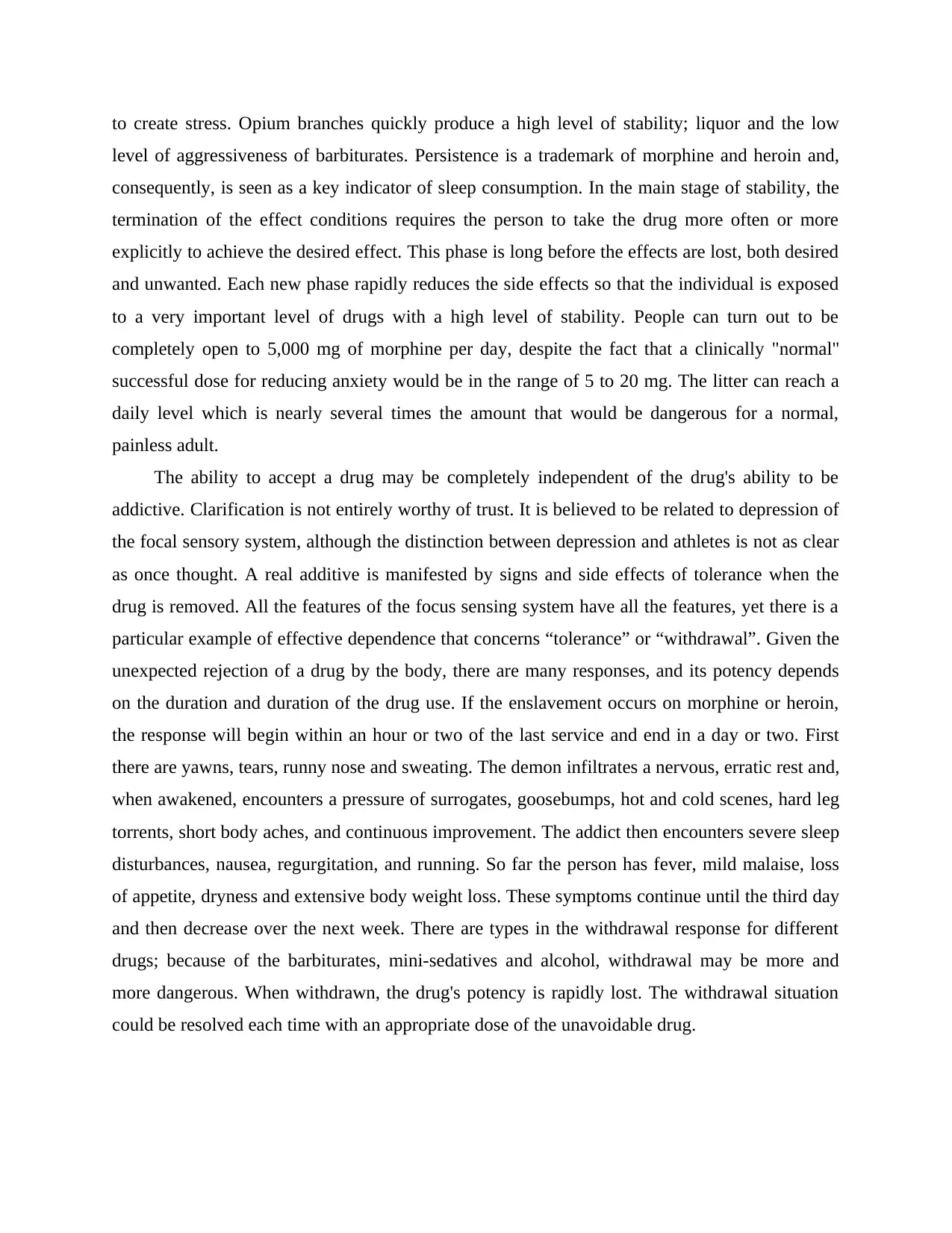
to create stress. Opium branches quickly produce a high level of stability; liquor and the low
level of aggressiveness of barbiturates. Persistence is a trademark of morphine and heroin and,
consequently, is seen as a key indicator of sleep consumption. In the main stage of stability, the
termination of the effect conditions requires the person to take the drug more often or more
explicitly to achieve the desired effect. This phase is long before the effects are lost, both desired
and unwanted. Each new phase rapidly reduces the side effects so that the individual is exposed
to a very important level of drugs with a high level of stability. People can turn out to be
completely open to 5,000 mg of morphine per day, despite the fact that a clinically "normal"
successful dose for reducing anxiety would be in the range of 5 to 20 mg. The litter can reach a
daily level which is nearly several times the amount that would be dangerous for a normal,
painless adult.
The ability to accept a drug may be completely independent of the drug's ability to be
addictive. Clarification is not entirely worthy of trust. It is believed to be related to depression of
the focal sensory system, although the distinction between depression and athletes is not as clear
as once thought. A real additive is manifested by signs and side effects of tolerance when the
drug is removed. All the features of the focus sensing system have all the features, yet there is a
particular example of effective dependence that concerns “tolerance” or “withdrawal”. Given the
unexpected rejection of a drug by the body, there are many responses, and its potency depends
on the duration and duration of the drug use. If the enslavement occurs on morphine or heroin,
the response will begin within an hour or two of the last service and end in a day or two. First
there are yawns, tears, runny nose and sweating. The demon infiltrates a nervous, erratic rest and,
when awakened, encounters a pressure of surrogates, goosebumps, hot and cold scenes, hard leg
torrents, short body aches, and continuous improvement. The addict then encounters severe sleep
disturbances, nausea, regurgitation, and running. So far the person has fever, mild malaise, loss
of appetite, dryness and extensive body weight loss. These symptoms continue until the third day
and then decrease over the next week. There are types in the withdrawal response for different
drugs; because of the barbiturates, mini-sedatives and alcohol, withdrawal may be more and
more dangerous. When withdrawn, the drug's potency is rapidly lost. The withdrawal situation
could be resolved each time with an appropriate dose of the unavoidable drug.
level of aggressiveness of barbiturates. Persistence is a trademark of morphine and heroin and,
consequently, is seen as a key indicator of sleep consumption. In the main stage of stability, the
termination of the effect conditions requires the person to take the drug more often or more
explicitly to achieve the desired effect. This phase is long before the effects are lost, both desired
and unwanted. Each new phase rapidly reduces the side effects so that the individual is exposed
to a very important level of drugs with a high level of stability. People can turn out to be
completely open to 5,000 mg of morphine per day, despite the fact that a clinically "normal"
successful dose for reducing anxiety would be in the range of 5 to 20 mg. The litter can reach a
daily level which is nearly several times the amount that would be dangerous for a normal,
painless adult.
The ability to accept a drug may be completely independent of the drug's ability to be
addictive. Clarification is not entirely worthy of trust. It is believed to be related to depression of
the focal sensory system, although the distinction between depression and athletes is not as clear
as once thought. A real additive is manifested by signs and side effects of tolerance when the
drug is removed. All the features of the focus sensing system have all the features, yet there is a
particular example of effective dependence that concerns “tolerance” or “withdrawal”. Given the
unexpected rejection of a drug by the body, there are many responses, and its potency depends
on the duration and duration of the drug use. If the enslavement occurs on morphine or heroin,
the response will begin within an hour or two of the last service and end in a day or two. First
there are yawns, tears, runny nose and sweating. The demon infiltrates a nervous, erratic rest and,
when awakened, encounters a pressure of surrogates, goosebumps, hot and cold scenes, hard leg
torrents, short body aches, and continuous improvement. The addict then encounters severe sleep
disturbances, nausea, regurgitation, and running. So far the person has fever, mild malaise, loss
of appetite, dryness and extensive body weight loss. These symptoms continue until the third day
and then decrease over the next week. There are types in the withdrawal response for different
drugs; because of the barbiturates, mini-sedatives and alcohol, withdrawal may be more and
more dangerous. When withdrawn, the drug's potency is rapidly lost. The withdrawal situation
could be resolved each time with an appropriate dose of the unavoidable drug.
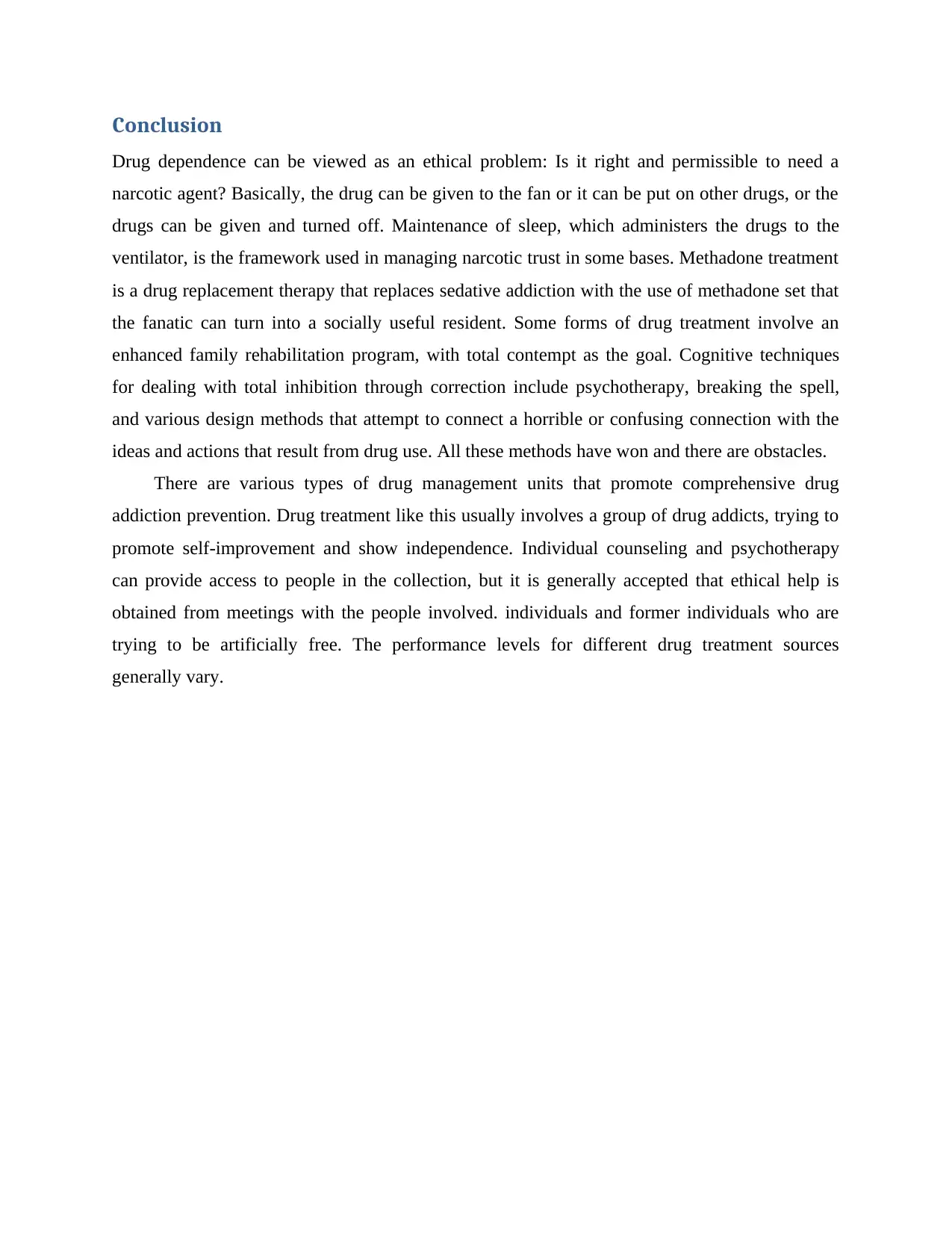
Conclusion
Drug dependence can be viewed as an ethical problem: Is it right and permissible to need a
narcotic agent? Basically, the drug can be given to the fan or it can be put on other drugs, or the
drugs can be given and turned off. Maintenance of sleep, which administers the drugs to the
ventilator, is the framework used in managing narcotic trust in some bases. Methadone treatment
is a drug replacement therapy that replaces sedative addiction with the use of methadone set that
the fanatic can turn into a socially useful resident. Some forms of drug treatment involve an
enhanced family rehabilitation program, with total contempt as the goal. Cognitive techniques
for dealing with total inhibition through correction include psychotherapy, breaking the spell,
and various design methods that attempt to connect a horrible or confusing connection with the
ideas and actions that result from drug use. All these methods have won and there are obstacles.
There are various types of drug management units that promote comprehensive drug
addiction prevention. Drug treatment like this usually involves a group of drug addicts, trying to
promote self-improvement and show independence. Individual counseling and psychotherapy
can provide access to people in the collection, but it is generally accepted that ethical help is
obtained from meetings with the people involved. individuals and former individuals who are
trying to be artificially free. The performance levels for different drug treatment sources
generally vary.
Drug dependence can be viewed as an ethical problem: Is it right and permissible to need a
narcotic agent? Basically, the drug can be given to the fan or it can be put on other drugs, or the
drugs can be given and turned off. Maintenance of sleep, which administers the drugs to the
ventilator, is the framework used in managing narcotic trust in some bases. Methadone treatment
is a drug replacement therapy that replaces sedative addiction with the use of methadone set that
the fanatic can turn into a socially useful resident. Some forms of drug treatment involve an
enhanced family rehabilitation program, with total contempt as the goal. Cognitive techniques
for dealing with total inhibition through correction include psychotherapy, breaking the spell,
and various design methods that attempt to connect a horrible or confusing connection with the
ideas and actions that result from drug use. All these methods have won and there are obstacles.
There are various types of drug management units that promote comprehensive drug
addiction prevention. Drug treatment like this usually involves a group of drug addicts, trying to
promote self-improvement and show independence. Individual counseling and psychotherapy
can provide access to people in the collection, but it is generally accepted that ethical help is
obtained from meetings with the people involved. individuals and former individuals who are
trying to be artificially free. The performance levels for different drug treatment sources
generally vary.
⊘ This is a preview!⊘
Do you want full access?
Subscribe today to unlock all pages.

Trusted by 1+ million students worldwide
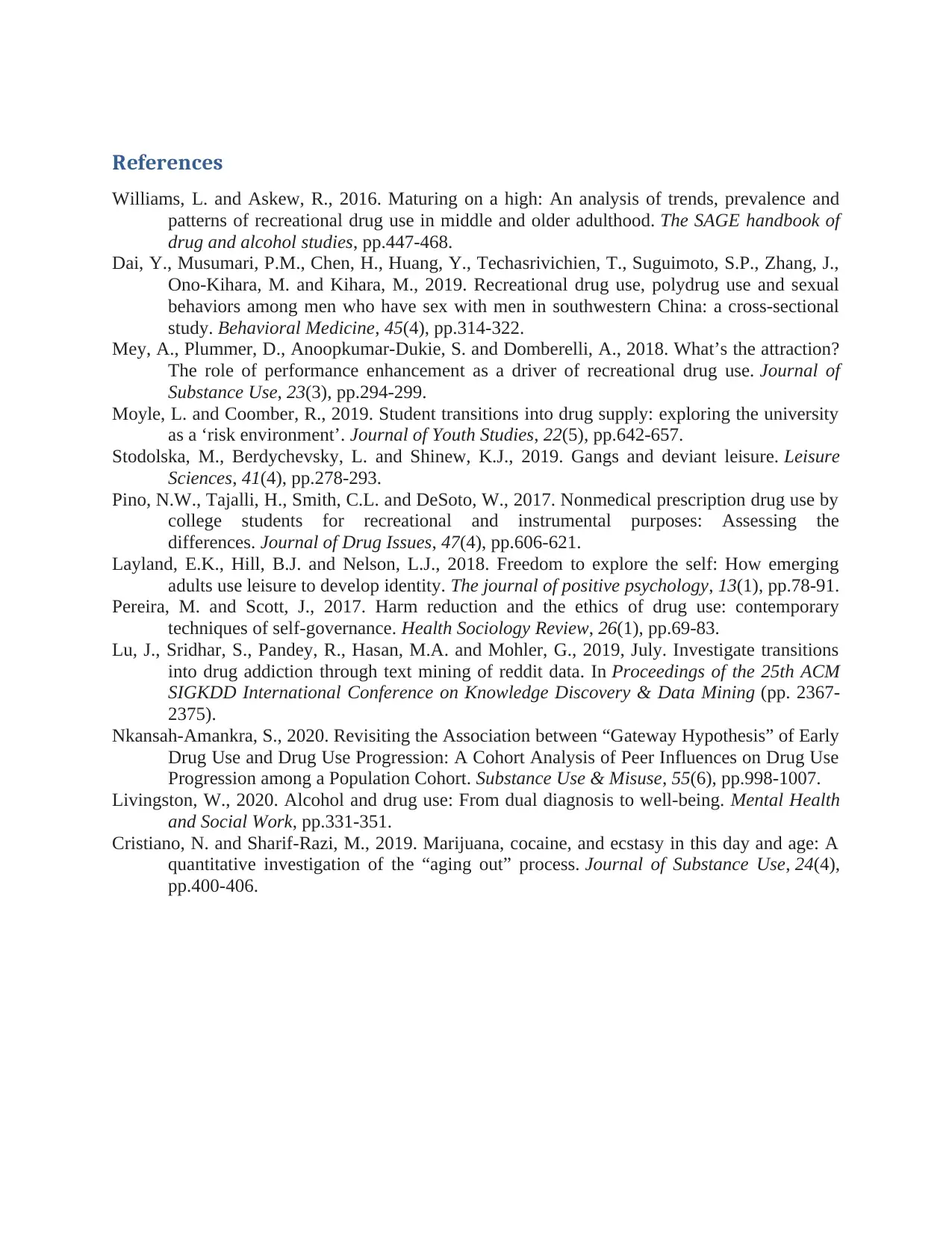
References
Williams, L. and Askew, R., 2016. Maturing on a high: An analysis of trends, prevalence and
patterns of recreational drug use in middle and older adulthood. The SAGE handbook of
drug and alcohol studies, pp.447-468.
Dai, Y., Musumari, P.M., Chen, H., Huang, Y., Techasrivichien, T., Suguimoto, S.P., Zhang, J.,
Ono-Kihara, M. and Kihara, M., 2019. Recreational drug use, polydrug use and sexual
behaviors among men who have sex with men in southwestern China: a cross-sectional
study. Behavioral Medicine, 45(4), pp.314-322.
Mey, A., Plummer, D., Anoopkumar-Dukie, S. and Domberelli, A., 2018. What’s the attraction?
The role of performance enhancement as a driver of recreational drug use. Journal of
Substance Use, 23(3), pp.294-299.
Moyle, L. and Coomber, R., 2019. Student transitions into drug supply: exploring the university
as a ‘risk environment’. Journal of Youth Studies, 22(5), pp.642-657.
Stodolska, M., Berdychevsky, L. and Shinew, K.J., 2019. Gangs and deviant leisure. Leisure
Sciences, 41(4), pp.278-293.
Pino, N.W., Tajalli, H., Smith, C.L. and DeSoto, W., 2017. Nonmedical prescription drug use by
college students for recreational and instrumental purposes: Assessing the
differences. Journal of Drug Issues, 47(4), pp.606-621.
Layland, E.K., Hill, B.J. and Nelson, L.J., 2018. Freedom to explore the self: How emerging
adults use leisure to develop identity. The journal of positive psychology, 13(1), pp.78-91.
Pereira, M. and Scott, J., 2017. Harm reduction and the ethics of drug use: contemporary
techniques of self-governance. Health Sociology Review, 26(1), pp.69-83.
Lu, J., Sridhar, S., Pandey, R., Hasan, M.A. and Mohler, G., 2019, July. Investigate transitions
into drug addiction through text mining of reddit data. In Proceedings of the 25th ACM
SIGKDD International Conference on Knowledge Discovery & Data Mining (pp. 2367-
2375).
Nkansah-Amankra, S., 2020. Revisiting the Association between “Gateway Hypothesis” of Early
Drug Use and Drug Use Progression: A Cohort Analysis of Peer Influences on Drug Use
Progression among a Population Cohort. Substance Use & Misuse, 55(6), pp.998-1007.
Livingston, W., 2020. Alcohol and drug use: From dual diagnosis to well-being. Mental Health
and Social Work, pp.331-351.
Cristiano, N. and Sharif-Razi, M., 2019. Marijuana, cocaine, and ecstasy in this day and age: A
quantitative investigation of the “aging out” process. Journal of Substance Use, 24(4),
pp.400-406.
Williams, L. and Askew, R., 2016. Maturing on a high: An analysis of trends, prevalence and
patterns of recreational drug use in middle and older adulthood. The SAGE handbook of
drug and alcohol studies, pp.447-468.
Dai, Y., Musumari, P.M., Chen, H., Huang, Y., Techasrivichien, T., Suguimoto, S.P., Zhang, J.,
Ono-Kihara, M. and Kihara, M., 2019. Recreational drug use, polydrug use and sexual
behaviors among men who have sex with men in southwestern China: a cross-sectional
study. Behavioral Medicine, 45(4), pp.314-322.
Mey, A., Plummer, D., Anoopkumar-Dukie, S. and Domberelli, A., 2018. What’s the attraction?
The role of performance enhancement as a driver of recreational drug use. Journal of
Substance Use, 23(3), pp.294-299.
Moyle, L. and Coomber, R., 2019. Student transitions into drug supply: exploring the university
as a ‘risk environment’. Journal of Youth Studies, 22(5), pp.642-657.
Stodolska, M., Berdychevsky, L. and Shinew, K.J., 2019. Gangs and deviant leisure. Leisure
Sciences, 41(4), pp.278-293.
Pino, N.W., Tajalli, H., Smith, C.L. and DeSoto, W., 2017. Nonmedical prescription drug use by
college students for recreational and instrumental purposes: Assessing the
differences. Journal of Drug Issues, 47(4), pp.606-621.
Layland, E.K., Hill, B.J. and Nelson, L.J., 2018. Freedom to explore the self: How emerging
adults use leisure to develop identity. The journal of positive psychology, 13(1), pp.78-91.
Pereira, M. and Scott, J., 2017. Harm reduction and the ethics of drug use: contemporary
techniques of self-governance. Health Sociology Review, 26(1), pp.69-83.
Lu, J., Sridhar, S., Pandey, R., Hasan, M.A. and Mohler, G., 2019, July. Investigate transitions
into drug addiction through text mining of reddit data. In Proceedings of the 25th ACM
SIGKDD International Conference on Knowledge Discovery & Data Mining (pp. 2367-
2375).
Nkansah-Amankra, S., 2020. Revisiting the Association between “Gateway Hypothesis” of Early
Drug Use and Drug Use Progression: A Cohort Analysis of Peer Influences on Drug Use
Progression among a Population Cohort. Substance Use & Misuse, 55(6), pp.998-1007.
Livingston, W., 2020. Alcohol and drug use: From dual diagnosis to well-being. Mental Health
and Social Work, pp.331-351.
Cristiano, N. and Sharif-Razi, M., 2019. Marijuana, cocaine, and ecstasy in this day and age: A
quantitative investigation of the “aging out” process. Journal of Substance Use, 24(4),
pp.400-406.
1 out of 7
Your All-in-One AI-Powered Toolkit for Academic Success.
+13062052269
info@desklib.com
Available 24*7 on WhatsApp / Email
![[object Object]](/_next/static/media/star-bottom.7253800d.svg)
Unlock your academic potential
Copyright © 2020–2025 A2Z Services. All Rights Reserved. Developed and managed by ZUCOL.
